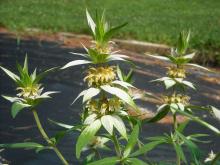Monarda punctata (spotted beebalm) is an under-appreciated native species, very different looking than what one normally associates with Monarda. It has yellow flowers that are spotted, and even showier colorful bracts that are pink shading to white in my plants. Web photos reveal it is quite variable in color, flowers from light yellow to dark orangish-yellow, bracts can be red, green, buff, or yellow. Best treated as a self-sowing short-lived perennial or biennial. It has never been a pest, just a few volunteers coming up each year, which I welcome. The tiers of bloom somehow conjure thoughts of Japanese pagodas and pineapples :D Also reminds me of a Phlomis.
Does any else grow this? What color are your plants?
USDA distribution map and info page, very wide distribution in Eastern North America and central Southwestern USA, and disjunct in California.
http://plants.usda.gov/java/profile?symbol=MOPU
Comments
Re: Monarda punctata - spotted beebalm
This plant is isn't called beebalm for nothing, it also attracts the wonderful-to-watch large mud dauber wasps.
Re: Monarda punctata - spotted beebalm
Interesting! It brings to mind an unrelated observation, which is how angelica seem very attractive to wasps, as well (rather than to bees it seems).
Re: Monarda punctata - spotted beebalm
Interesting! It brings to mind an unrelated observation, which is how angelica seem very attractive to wasps, as well (rather than to bees it seems).
The mud dauber wasps, two types, an iridescent blue-black species, and an orange and black species, are all over my alliums right now, they like Monarda punctata too, but they are waiting for my Clethra alnifolia 'Ruby Spice', which drives all pollinators wild! This photo shows a plant growing in my friend's garden (Marsha Russell), lacking the pink color in the bracts, but she tells me she used to get lots of seedlings and would cull out the paler forms in favor of the pink-bracted forms, but now that she doesn't have much of it left, she has allowed what remains, the mostly white-bracted form.
Re: Monarda punctata - spotted beebalm
Both are very nice - the pale pink, and the white-bracted. Seeing your photos, I wouldn't mind growing it again... and see if I can get it self-sustaining this time. Do you collect the seeds, Mark?
Re: Monarda punctata - spotted beebalm
Both are very nice - the pale pink, and the white-bracted. Seeing your photos, I wouldn't mind growing it again... and see if I can get it self-sustaining this time. Do you collect the seeds, Mark?
Never bothered collecting the seeds, just let it self sow. Given that I currently only have one plant flowering (or growing), means that I should indeed collect seed and sow some this year. If it sets seed, I'll try to remember that you're interested (but feel free to remind me, my mind is a total sieve).



I grew it for a few years but no longer have it - short-lived, as you say. Mine was, more or less, about the same washed-out pink-white bracts as you show, with brown-spotted yellow flowers (I guess the spotting is a little different). A mid-August bloomer here...